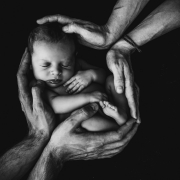Original Unity Part 1: Flesh of my Flesh
In previous articles, we saw how Pope St. John Paul II used the term “original solitude” to refer to the human search for identity. As we interact with the world around us seeking answers to fundamental questions about who we are and why we are here, we discover that we are alone among bodily creatures. This is so because only the human body reveals a person — a free, rational subject capable of self-awareness and self-determination. As a person, man is unique in the physical world, and the human body, therefore, takes on a special, sacramental character. The human body reveals and makes present the spiritual reality we call “person” and points in a veiled way to his transcendent Creator in whose image man is made.
Having explored these fundamental truths of our identity, let us turn to the second of the original experiences: original unity. The pope guides us to reflect on Genesis 2 where we read about the creation of the woman from the rib of man. Man’s search for his identity left him longing for a “helper fit for him” (Gen 2:20b), but what sort of “help” is this that he is lacking? He needs someone like himself to help him discover his identity and vocation. He needs another embodied person.
Guiding man along the path of self-discovery, the Lord forms the woman out of man’s rib and presents her to him. In response, he exclaims, “This at last is bone of my bone and flesh of my flesh” (Gen 2:23a). The phrase “at last” signifies that the search is over; his helper has been found. The rest of the sentence speaks to the kind of help that the woman provides. Her embodied presence shows the man who he is and what he is made for. Her body is like the man’s in that her body too reveals a person. Her body too “is capable of making visible what is invisible: the spiritual and the divine” (TOB 19:5). Her body reveals another “partner with the Absolute” who is capable of “genuinely human activity” (TOB 7:2). Like me, she too is “set into a unique, exclusive, and unrepeatable relationship with God himself” (TOB 6:2).
With the creation of the woman, the biblical language used in Genesis shifts from speaking about man in an inclusive sense (i.e., humanity) to using the gendered language of man/male and woman/female. This is not to say that human nature is now divided or that man and woman are separate kinds of creatures. Rather, male and female now constitute “two different ‘incarnations,’ that is, two ways in which the same human being, created in the image of God, ‘is a body’” (TOB 8.4). Human nature is indeed one, yet there are now two ways of being human: male and female. Though fundamentally distinct, man and woman are utterly equal in dignity, united in the same human nature. As Pope St. John Paul II remarked in his apostolic letter on the dignity of women (Mulieris dignitatem), “Man is a person, man and woman equally so, since both were created in the image and likeness of the personal God” (no. 6). Continuing to reflect on the unity of man and woman in their common humanity, the pope went on to observe,
“The woman is created by God ‘from the rib’ of the man and is placed at his side as another ‘I’, as the companion of the man, who is alone in the surrounding world of living creatures and who finds in none of them a ‘helper’ suitable for himself. Called into existence in this way, the woman is immediately recognized by the man as ‘flesh of his flesh and bone of his bones’ and for this very reason she is called ‘woman’” (no. 6).
The equal dignity of man and woman is unmistakable and founded on our creation as embodied persons sharing the same human nature. Equally unmistakable is the fact that our bodies differ precisely in our maleness or femaleness. This distinction of sex is a decisive aspect of our human identity and vocation and will therefore be the focus of further reflections.
Note: This article is part of a series of reflections on Pope St. John Paul II’s “Theology of the Body”.
Continue Reading: Original Unity Part 2: The Sexual Difference

Written by, Dr. Andrew Sodergren, M.T.S., Psy.D.,
Director of Ruah Woods Psychological Services
(Article originally published in The Catholic Telegraph, November 2021 Issue, the official magazine of the Archdiocese of Cincinnati)









